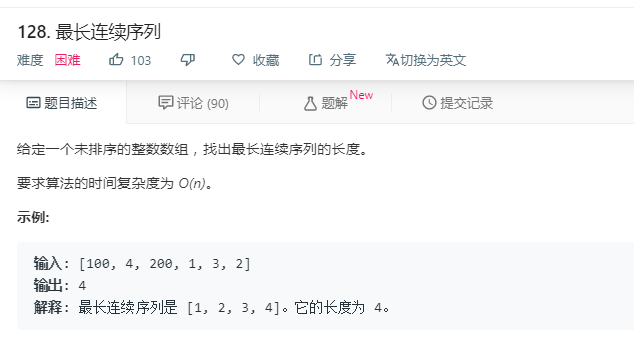leetcode 128最长连续序列

方法一:使用快排:
//排序法,时间O(nlogn),使用STL,只是验证一下思想,非正解; class Solution { public: int longestConsecutive(vector<int>& nums) { sort(nums.begin(),nums.end()); int res=0; for(int i=0;i<nums.size();i++){ int step=0,len=1; while(i+step!=nums.size()-1&&nums[i+step+1]-nums[i+step]<=1){ if(nums[i+step]+1==nums[i+step+1]) len++; step++; } res=max(res,len); i+=step; } return res; } };
方法二:使用并查集如题所说达到O(n)
方法三:使用哈希表O(n)
//哈希表结合染色,建立一个哈希表,然后遍历之后计数每个元素周围所有相邻元素并染色,记录个数;O(n)复杂度 class Solution { public: int longestConsecutive(vector<int>& nums) { int len=nums.size(); if(len<=1) return len; unordered_map<int,int> m; int res=0; for(int n:nums) m[n]=1; for(int n:nums){ int i=n,j=n; int cnt=1; if(m[n]==0) continue; else m[n]=0; while(m[i+1]==1){ i++; m[i]=0; } while(m[j-1]==1){ j--; m[j]=0; } cnt=i-j+1; res=cnt>res?cnt:res; } return res; } };
别人家的哈希表:
/**** 通过哈希表记录边界信息 neither i+1 nor i-1 has been seen: m[i]=1; both i+1 and i-1 have been seen: extend m[i+m[i+1]] and m[i-m[i-1]] to each other; only i+1 has been seen: extend m[i+m[i+1]] and m[i] to each other; only i-1 has been seen: extend m[i-m[i-1]] and m[i] to each other. *****/ class Solution { public: int longestConsecutive(vector<int>& nums) { int len=nums.size(); if(len<=1) return len; unordered_map<int,int> m; int res=0; for(int i:nums){ if(m[i]) continue; //后面表达式为将m[i]和这一段连续序列的边界全部赋值为他的长度 //边界只可能为m[i-m[i-1]]到m[i+m[i+1]],m[i]到m[i+m[i+1]],m[i-m[i-1]]到m[i]这几种情况,因此更新三者的值为新连续序列的长度即可 //又因为没有的元素哈希值为0,所以m[i]左右元素的m[i-1]+m[i+1]+1为新序列的长度; res=max(res,m[i]=m[i+m[i+1]]=m[i-m[i-1]]=m[i-1]+m[i+1]+1); } return res; } };
别人家的使用hashset 和 hashtable:
hashset:
/**** 通过哈希set 将nums转化为哈希set,然后对哈希set进行遍历,寻找连续片段的左边界,然后num+1进行遍历。 可以证明每个元素将被访问2遍,for中一遍,while一遍,所以time O(n),space O(n); 由于int会产生越界,可以使用long,也可以进行边界检测,INT_MAX break; *****/ class Solution { public: int longestConsecutive(vector<int>& nums) { int res=0; unordered_set<int> h(nums.begin(),nums.end()); for(int num:nums){ int l=0; if(!h.count(num-1)){ while(h.count(num)!=0){ ++l; if(num==INT_MAX) break; ++num; } res=res>l?res:l; } } return res; } };
hashtable:
/**** 通过哈希table solution 1: hashtable (key,len) case1: no neighboors h[num]=1; case2: one neighboor l=h[num-1] or r=h[num+1] h[num]=h[num-1]=l+1 or h[num]=h[num+1]=r+1 case3: two neighboors l=h[num-1] r=h[num+1] h[num]=h[num-1]=h[num+1]=l+r+1 *****/ class Solution { public: int longestConsecutive(vector<int>& nums) { int res=0; unordered_map<int,int> h; for(int num:nums){ if(h[num]!=0) continue; int l=h[num-1]; int r=h[num+1]; int t=l+r+1; h[num]=h[num+r]=h[num-l]=t; res=res>t?res:t; } return res; } };
哈希set
/**** 通过哈希set 将nums转化为哈希set,然后对哈希set进行遍历,寻找连续片段的左边界,然后num+1进行遍历。 可以证明每个元素将被访问2遍,for中一遍,while一遍,所以time O(n),space O(n); 由于int会产生越界,可以使用long,也可以进行边界检测,INT_MAX break; *****/ class Solution { public: int longestConsecutive(vector<int>& nums) { int res=0; unordered_set<int> h(nums.begin(),nums.end()); for(int num: nums){ int l=0; if(h.count(num-1)==0){ while(h.count(num)>0){ l++; if(num==INT_MAX) break; num++; } } res=res>l?res:l; } return res; } };
解决方案1:哈希表(关键,len) case1:没有neighboorsh (num) = 1,例2:一个neighboorl = h [num-1]或r = h (num + 1) h (num) = h [num-1] = l + 1或h (num) = h (num + 1) = r + 1 case3:两个neighboorsl = h [num-1] r = h (num + 1) h (num) = h [num-1] = h (num + 1) = l + r + 1
* * * * * /类解决方案{公众:int longestConsecutive(向量< int > & num) {int res = 0; unordered_map < int, int > h;为(int num: num){如果(h (num) ! = 0)继续;int l = h [num-1]; int r = h (num + 1); int t = l + r + 1; h (num) = h (num + r) = h [num-l] = t; res = res > t ? res: t;}返回res;}};



 浙公网安备 33010602011771号
浙公网安备 33010602011771号